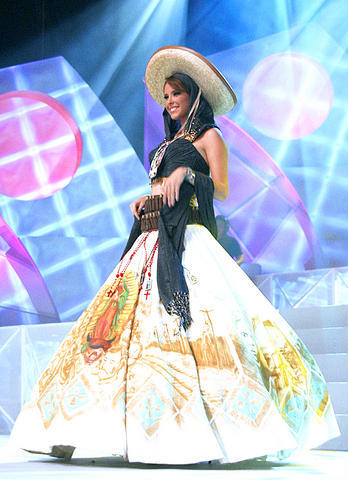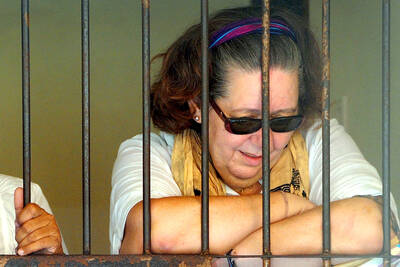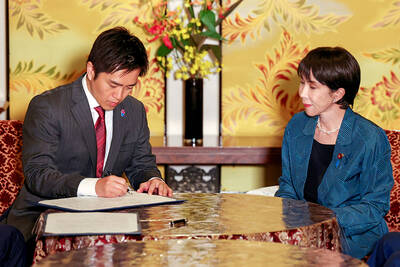Miss Mexico is redesigning her Miss Universe pageant dress -- not because it is too slinky or low-cut, but because it is too violent.
The floor-length dress, belted by bullets and accented by sketches of hangings during Mexico's Roman Catholic uprising in the 1920s, outraged Mexicans who said it was in poor taste and inappropriate for the world's most important beauty contest.
Critics said it glorified violence in a country where a battle between rival drug gangs has brought a wave of killings and beheadings.

PHOTO: AP
Designers who helped select the dress from among 30 entries said they had wanted something that represented the nation's culture and history, especially since Mexico City is hosting the pageant next month.
"We wanted a dress that made you think of Mexico," said Hector Terrones, who served on the selection committee, to the leftist La Jornada newspaper.
But many Mexicans weren't happy about the dress.
Cut from a traditional, natural cotton called manta, the dress depicted scenes from the 1926-1929 Cristero war, an uprising by Roman Catholic rebels against Mexico's secular government, which was imposing fiercely anti-clerical laws. Tens of thousands of people died.
The dress unleashed a storm of criticism. La Jornada carried close-ups of controversial images from the dress, including a man facing a firing squad.
"It's inappropriate to use images of this Cristero war that cost so many lives and was so pointless," said Guadalupe Loaeza, a contemporary Mexican writer.
Miss Mexico, Rosa Maria Ojeda, presented the dress on March 29, showing off the billowing, hoop skirt adorned with sketches of rebels hanging from posts. Rosaries and scapularies hung from her bullet-studded, bandolier belt. She completed the outfit with a huge crucifix necklace, a black halter top and a wide-brimmed sombrero.
The gown's designer, Maria del Rayo Macias, told La Jornada that "we are descendants of Cristeros. Whether we like it or not, it's a part of who we are."
Macias is from Guadalajara, a city in what was the Cristero heartland.
La Jornada columnist Jorge Camil said a dress was not the place to recount the event.
"It would be like Miss USA wearing a dress showing images of the Ku Klux Klan in the Deep South, with their hoods, their burning crosses and beer cans," he wrote. "A beauty contest is very far from being the right place to vent political and religious ideologies."
Ojeda's representatives released a statement late on Monday stating that the dress would be "modified" due to "the concerns that have surfaced regarding the design."
Pageant spokeswoman Esther Swan said the new skirt will have ribbons and ruffles -- but no images.
Mexican church officials also argued that using the war as a fashion statement was disrespectful to the thousands who died, some of whom were later named saints.
The conflict was the culmination of a century of bloody struggles over liberal attempts to slash the power of the church, which had been an arm of the Spanish colonial government for three centuries, owning vast tracts of land and savagely persecuting rival religions.

Indonesia was to sign an agreement to repatriate two British nationals, including a grandmother languishing on death row for drug-related crimes, an Indonesian government source said yesterday. “The practical arrangement will be signed today. The transfer will be done immediately after the technical side of the transfer is agreed,” the source said, identifying Lindsay Sandiford and 35-year-old Shahab Shahabadi as the people being transferred. Sandiford, a grandmother, was sentenced to death on the island of Bali in 2013 after she was convicted of trafficking drugs. Customs officers found cocaine worth an estimated US$2.14 million hidden in a false bottom in Sandiford’s suitcase when

CAUSE UNKNOWN: Weather and runway conditions were suitable for flight operations at the time of the accident, and no distress signal was sent, authorities said A cargo aircraft skidded off the runway into the sea at Hong Kong International Airport early yesterday, killing two ground crew in a patrol car, in one of the worst accidents in the airport’s 27-year history. The incident occurred at about 3:50am, when the plane is suspected to have lost control upon landing, veering off the runway and crashing through a fence, the Airport Authority Hong Kong said. The jet hit a security patrol car on the perimeter road outside the runway zone, which then fell into the water, it said in a statement. The four crew members on the plane, which

Japan’s ruling Liberal Democratic Party (LDP) and its junior partner yesterday signed a coalition deal, paving the way for Sanae Takaichi to become the nation’s first female prime minister. The 11th-hour agreement with the Japan Innovation Party (JIP) came just a day before the lower house was due to vote on Takaichi’s appointment as the fifth prime minister in as many years. If she wins, she will take office the same day. “I’m very much looking forward to working with you on efforts to make Japan’s economy stronger, and to reshape Japan as a country that can be responsible for future generations,”

SEVEN-MINUTE HEIST: The masked thieves stole nine pieces of 19th-century jewelry, including a crown, which they dropped and damaged as they made their escape The hunt was on yesterday for the band of thieves who stole eight priceless royal pieces of jewelry from the Louvre Museum in the heart of Paris in broad daylight. Officials said a team of 60 investigators was working on the theory that the raid was planned and executed by an organized crime group. The heist reignited a row over a lack of security in France’s museums, with French Minister of Justice yesterday admitting to security flaws in protecting the Louvre. “What is certain is that we have failed, since people were able to park a furniture hoist in the middle of